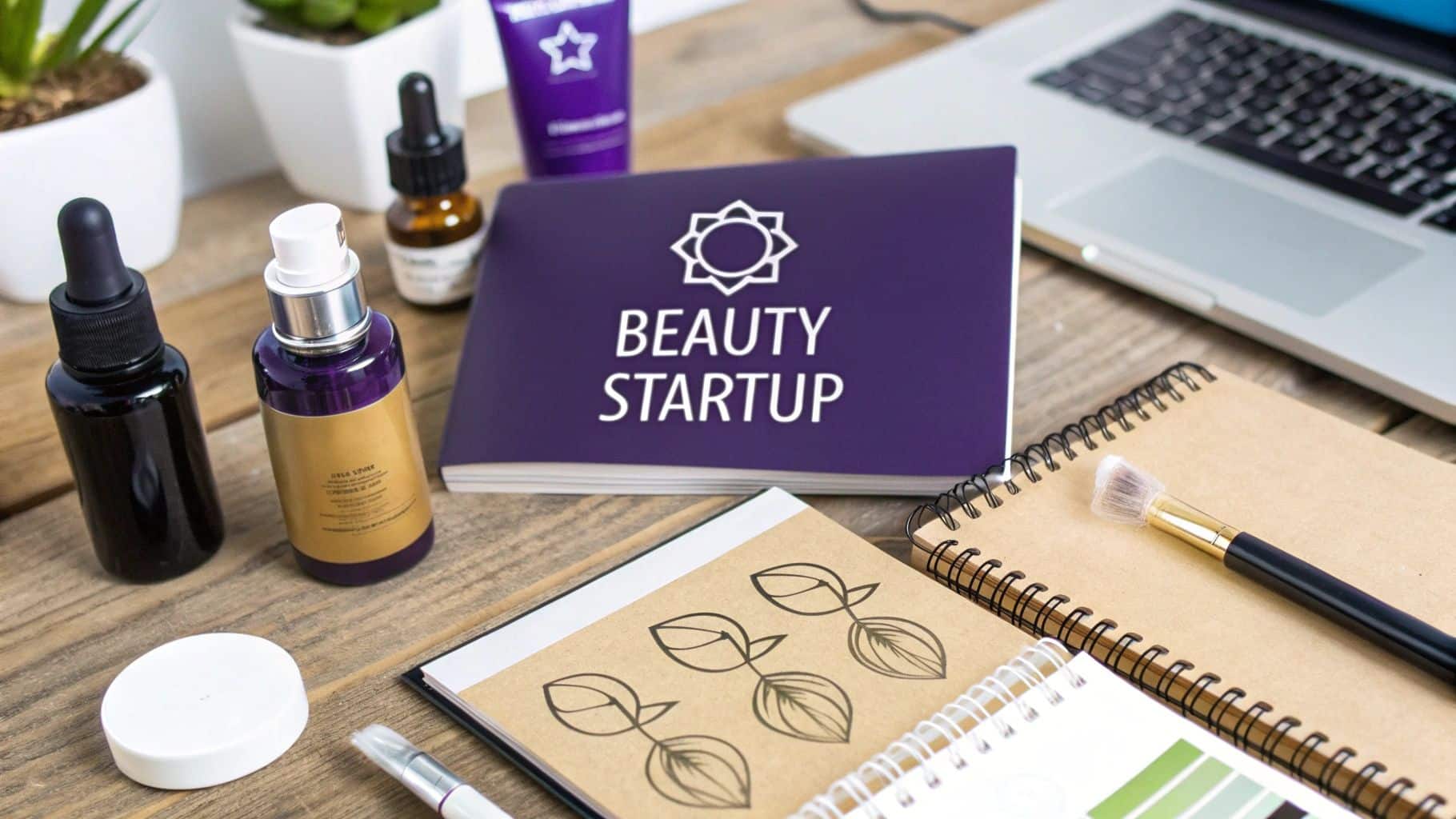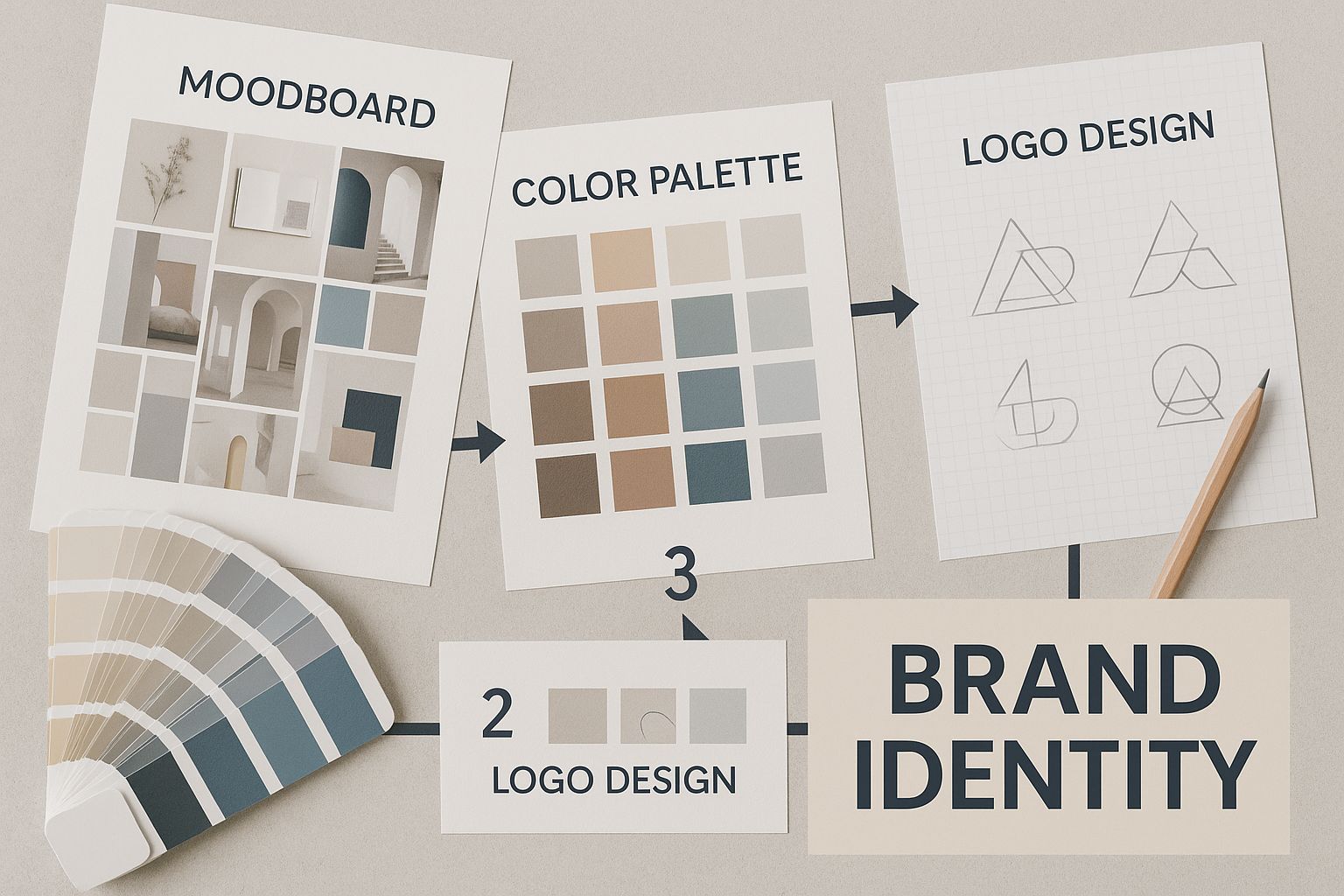How to Start a Beauty Business in 8 Actionable Steps

So, you're ready to launch a beauty brand. It's a huge undertaking, but when broken down, it's about a few core actions: finding your unique corner in the market, mapping out a solid business plan, handling your legal requirements, and creating products people will rave about. Once that foundation is solid, you can shift your focus to building a memorable brand and a marketing plan that reaches your dream customers.
Your Blueprint for Launching a Beauty Brand

Starting a beauty brand can feel like a massive project, but with a clear roadmap, it’s completely achievable. While the beauty world is competitive, it’s also bursting with opportunities for new voices and innovative products that solve real problems for a specific audience. Success isn't just about a great formula; it's fueled by passion, resilience, and a deep, genuine understanding of who you're creating for.
The global beauty industry is booming, projected to hit a staggering $1.15 trillion by 2034. That growth signals incredible potential for new entrepreneurs like you. Skincare still reigns supreme, making up 40% of the industry’s revenue, with hair care and cosmetics following closely behind.
Think of this guide as your practical framework—we’ll walk through each stage of the journey, step by step.
Laying the Foundation for Success
Before you start formulating products or planning marketing campaigns, you must define your core idea. What gap in the market will you fill? It could be vegan makeup for ultra-sensitive skin, sustainable hair care, or products that celebrate an overlooked demographic.
To bring this vision to life, think visually. A great way to get inspired is by looking at what others are doing. Exploring different examples of online portfolios can spark ideas for how to present your brand's unique aesthetic and tell its story.
The most successful beauty brands are almost always born from a founder's genuine passion to solve a problem they've personally faced. Your story is your greatest asset—it's what will create a real connection with a loyal community.
From there, consider how your brand will appear in the real world. A critical part of your blueprint is exploring smart labelling strategies for startup businesses to ensure your products stand out, whether on a physical or digital shelf.
To help you stay organized, here's a checklist breaking down the essential pillars of launching your brand.
Beauty Business Launch Checklist
| Core Pillar | Key Action | Why It Matters |
|---|---|---|
| Market Niche | Identify an underserved audience or unsolved problem. | A clear niche reduces competition and helps you build a loyal community from day one. |
| Business Plan | Outline your mission, financial projections, and operational strategy. | This is your roadmap. It guides decisions and is crucial for securing funding or partners. |
| Legal & Compliance | Register your business, trademark your name, and ensure product safety. | This protects you, your brand, and your customers. It's non-negotiable for long-term success. |
| Branding & Product | Develop your brand story, visual identity, and hero products. | Your brand is your promise to the customer. Great products are what keep them coming back. |
| Marketing & Launch | Create a marketing plan and a professional website to sell your products. | This is how you'll connect with your audience, drive sales, and build momentum. |
This table isn't just a to-do list; it's a strategic framework. By methodically tackling each of these pillars, you're not just launching a product—you're building a sustainable, resilient beauty brand ready to make its mark.
How to Find Your Niche in a Crowded Market

Before creating your dream product, you need to know exactly who you’re making it for. The secret to launching a successful beauty brand isn't pleasing everyone; it’s finding a specific group whose needs are being ignored and connecting with them on a deeper level. Finding this niche is your most important first step.
Think of it as finding an empty spot on a crowded shelf at Sephora. Big-name brands try to be everything to everyone, leaving huge gaps for founders like you to serve a dedicated community. Success stories are everywhere—brands built for men’s makeup, skincare for women navigating menopause, or eco-friendly solid shampoos that ditch plastic waste.
Your mission is to become a beauty detective. You’re here to uncover hidden opportunities and confirm there’s a real, paying audience waiting for what you have to offer.
Uncovering Underserved Customer Needs
So where do you start? The best place to find your big idea is where people are already talking—and complaining. Social media and product review sites are goldmines of raw, unfiltered feedback. They show you what customers want, what they hate, and what they're wishing for.
Make a habit of spending a few hours a week doing this kind of "social listening." You’ll start seeing patterns that could spark your next big idea.
Actionable Discovery Methods:
- Analyze TikTok Trends: Don't just scroll—analyze. Dive into hashtags like #beautytok, #skincarehacks, and #productempties. Pay close attention to "dupes" (cheaper alternatives to high-end products) or DIY solutions. When people are mixing their own concoctions at home, it’s a clear sign of a market gap.
- Scour Product Reviews: Visit major retailers like Sephora, Ulta, or Cult Beauty. Pick a product category you're interested in and filter the reviews down to one and two stars. What are the common complaints? Is it the shade range, the fragrance, the packaging, or that it just doesn't work? These negative reviews are your treasure map to creating something better.
- Explore Niche Communities: Dive into Reddit subs like r/SkincareAddiction or Facebook groups dedicated to specific concerns (like "Curly Hair Care" or "Rosacea Support"). Listen to the exact words people use, the holy grail products they rave about, and the problems they can't seem to solve.
Your goal isn't just to find a niche, but to find your niche. The most powerful brands are built on genuine passion. Pick a problem you truly care about solving. That authenticity will become the heart of your brand and what makes customers fall in love with you.
Validating Your Niche Idea
Okay, you have a great idea for a niche. Now what? You need to make sure it’s a viable business. An idea is only great if people are willing to pay for a solution. This is where you put on your analyst hat and start researching your competition and future customers.
A competitive analysis isn't just a list of other brands. It's about deeply understanding their strengths and, more importantly, their weaknesses—because that's where you'll shine.
Building a Competitive Snapshot:
| Competitor Analysis Area | Questions to Ask Yourself | What This Tells You |
|---|---|---|
| Product Offering | What are their hero products? What ingredients do they highlight? | Identifies market standards and opportunities for unique formulas. |
| Brand Voice & Story | How do they talk to customers? What’s their core message? | Reveals how to make your brand's personality and mission stand out. |
| Customer Reviews | What do customers love and hate? Where are they falling short? | Pinpoints specific pain points your brand can solve. |
| Price Point | Where do they fit? (Luxury, mass-market, budget) | Helps you determine a profitable and competitive pricing strategy. |
This analysis helps you define your unique value proposition (UVP)—the one thing that makes you different and better. Maybe you’ll offer a more inclusive shade range, use cleaner ingredients, or create stunning, sustainable packaging.
The global cosmetics market was valued at $311.23 billion in 2024. While women's cosmetics hold a 62.9% revenue share, don't overlook emerging segments. Men's cosmetics are growing, with 52% of men reporting they've increased their beauty spending. This data shows that focusing on an underserved group can be a powerful move. You can find more of the latest beauty industry statistics and trends to get more ideas.
With your UVP locked in, create a detailed customer persona. This isn't a generic description; it's a profile of your ideal customer. Give them a name, age, job, and lifestyle. Most importantly, map out their biggest beauty goals and frustrations. This persona will be your North Star, guiding every decision you make, from product development to Instagram captions.
Developing Your Signature Product Line
Once you’ve locked in your niche, the real fun begins. This is where your vision becomes a tangible product—something people can see, touch, and fall in love with. Developing your signature product line isn’t just about what’s inside the bottle; it’s about creating an entire brand experience that hooks your audience from the first glance.
Your brand is more than a logo or a catchy name. It’s the story you tell and the feeling you create. A strong brand story is the soul of your business, connecting your mission and values to what your customers are looking for. What’s your unique promise? Are you about science-backed formulas, transparent ingredients, or pure luxury?
This core story will guide every decision you make, from product names to packaging design. It keeps everything cohesive and authentic, which is how you build the trust that turns curious shoppers into loyal fans.
Choosing Your Product Creation Path
Bringing a beauty product to life isn't a one-size-fits-all process. You have three main paths, each with its own pros and cons. Your choice will depend on your budget, timeline, and how unique your formula needs to be.
Making the right call here is a big deal—it sets the foundation for your brand's quality and scalability. Let's break down the options.
-
Private Label: This is the fastest and most budget-friendly way to get started. You choose a pre-existing, lab-tested formula from a manufacturer's catalog and apply your own branding and packaging. It’s a great way to enter the market quickly with lower upfront costs and smaller minimum order quantities (MOQs). The main drawback? The formula isn't exclusive to you; other brands could be selling the same thing.
-
White Label: This is a step up from private label, offering more room for customization. You start with a manufacturer's base formula but can tweak it by adding or modifying things, like a specific botanical extract or your signature scent. This gives your product more personality without the cost and time of a custom formula.
-
Contract Manufacturing (Custom Formulation): This is for founders who want a completely unique product. You'll work with a cosmetic chemist to develop a formula from scratch to your exact specifications. While it gives you total control and a competitive edge, it's also the most expensive and time-consuming route, usually involving higher MOQs and significant investment in R&D and testing.
There is no shame in starting with a private or white label manufacturer. It lets you test the market and build your brand without the huge financial risk of custom formulation. You can always upgrade to custom products later as your business grows and you have more capital.
This visual shows the flow of building your brand identity, from brainstorming to the finished product.

It’s a great reminder that a strong brand doesn't just happen by accident. It's a deliberate process, moving from abstract ideas like mood boards to the concrete things your customers will hold in their hands.
Finding Partners and Sourcing Ingredients
Whether you choose a ready-made formula or create your own, finding the right partners is crucial. You aren't just looking for a supplier; you're looking for a partner who understands your vision and is as committed to quality and safety as you are.
When evaluating potential labs or manufacturers, ask the tough questions. Are they FDA-compliant? Do they follow Good Manufacturing Practices (GMP)? Can they provide documentation for their ingredients, especially if you’re building an ethical or "clean" beauty brand?
Here’s a quick checklist to help you vet your manufacturing partner:
- Request Samples: Never commit to a large order without testing the product yourself. Evaluate its texture, scent, and performance.
- Verify Certifications: Ask for proof of GMP compliance, organic certifications, or other claims they make. A legitimate lab will provide this.
- Discuss MOQs and Pricing: Get a clear understanding of their minimum order quantities and a full cost breakdown per unit.
- Check Their Reputation: Do some research. Look for reviews or ask for references from other brands they’ve worked with.
Sourcing high-quality ingredients is just as important—it’s the heart of your product's effectiveness. Research shows that 76% of bloggers publish "how-to" content because it provides clear, actionable value. Think of your ingredient list as its own "how-to" story, explaining how your product delivers its results.
If you’re sourcing ingredients directly for a custom formula, make transparent supply chains a priority. This is non-negotiable if you're making claims like "ethically sourced," "vegan," or "cruelty-free." Your brand’s credibility is on the line. Ensuring your product development aligns with your brand values is how you build a beauty business with integrity.
Alright, let's tackle the not-so-glamorous but essential part of building your beauty empire: the legal and financial stuff. Getting this foundation right from day one will save you from major headaches later. Think of it as the primer before the foundation—it sets you up for a flawless finish.
First, you need to decide on your business's legal structure. This choice dictates how you pay taxes and how much personal risk you're taking on. For most new beauty entrepreneurs, it comes down to two main options.
Choosing Your Business Structure
Making this call is a strategic move that will protect you as you grow.
-
Sole Proprietorship: This is the easiest way to get started. You and your business are one and the same legally. The setup is simple with minimal paperwork. The big catch? There’s no legal separation between your business debts and personal assets. If your business gets into trouble, your personal savings, car, or home could be at risk.
-
Limited Liability Company (LLC): An LLC creates a legal wall between your personal life and your business. If something goes wrong, your personal assets are shielded. It requires more paperwork and filing fees, but the peace of mind is worth it.
My two cents? While the simplicity of a sole proprietorship is appealing, go for the LLC. I’ve seen too many founders regret not having that protection when things got complicated. The security it gives you as you start signing bigger contracts and taking on inventory is invaluable.
Getting Official: Registration and Compliance
Once you've picked a structure, it’s time to make it official. These steps are required to operate legally in the US.
-
Register Your Business Name: Unless you're operating under your own legal name, you'll need to register a "Doing Business As" (DBA) name. If you form an LLC, your business name gets registered as part of that process.
-
Get an Employer Identification Number (EIN): An EIN is like a Social Security number for your business. You'll need it to open a business bank account, hire employees, and file taxes. You can get one for free from the IRS website.
-
Secure Your Permits and Licenses: The beauty industry has strict regulations. Check with your city, county, and state for necessary business licenses. Since you're selling cosmetics, you also have to follow FDA rules for labeling, ingredient safety, and marketing claims.
Sorting Out Your Startup Finances
With the legal stuff handled, let's talk money. A realistic budget is your roadmap. It helps you see what you need to spend to get started and when you can expect to turn a profit.
Don’t just guess at numbers. Do your research and get real quotes. Your initial budget might look something like this:
| Expense Category | What It Covers | Estimated Cost (For a Small Launch) |
|---|---|---|
| Product Development | Formulation, first inventory order (MOQs), stability testing. | $3,000 – $10,000+ |
| Branding & Packaging | Logo design, boxes, tubes, jars, and labels. | $1,000 – $5,000 |
| Legal & Admin | LLC formation, trademark application, business insurance. | $500 – $1,500 |
| Website & E-commerce | Shopify subscription, theme purchase, essential apps. | $300 – $1,000 |
| Launch Marketing | Sending products to influencers, samples, a small ad budget. | $500 – $2,500 |
Funding is often the biggest hurdle. Many founders bootstrap (use their own savings) to retain 100% control. Others seek outside money. Securing the necessary capital is a critical step; discover comprehensive guidance on how to fund a startup to explore options like small business loans or friends and family rounds.
No matter which path you choose, open a separate business bank account immediately. Mixing business and personal funds is a recipe for a tax-season nightmare. Keep it clean from the start.
You’ve got a brilliant product and a brand story. What's next? A great product doesn't sell itself. This is where your go-to-market strategy comes in—the action plan that turns your brand into a business with paying customers. It’s your roadmap for launching smart and landing those first sales.
The most important piece of your digital real estate is a high-converting e-commerce website. This is your brand's home. Social media creates buzz, but your website is where sales happen. Platforms like Shopify make it easy to build a professional online store without needing a computer science degree. Your site must be fast, easy to navigate, and mobile-friendly—because that's where most customers are scrolling.
Generate That Pre-Launch Buzz
A successful launch starts weeks, or even months, before launch day. Your goal is to build an audience that is counting down the days until they can buy from you. This pre-launch phase is all about creating anticipation.
One of the best tools is an email list. Start with a simple "Coming Soon" landing page on your website. Give people a good reason to hand over their email addresses. Offer something juicy, like:
- Exclusive early access to shop the collection.
- A special launch-day discount (like 15% off their first order).
- A chance to win your entire product line.
You're not just collecting contacts; you're building a direct line to your most passionate followers. These people will be your first customers and your loudest cheerleaders.
Master Your Social Media Launch
If your website is the store, social media is your stage. For any beauty brand, being on platforms like Instagram and TikTok isn't optional—it’s essential. This is where you'll find your audience, tell your story visually, and show off what makes your products special.
For beauty brands with an online shop, mastering your ecommerce social media marketing that sells is a game-changer. It’s about more than posting pretty pictures; it's about building a community. Share behind-the-scenes peeks, create quick tutorials, and feature user-generated content like before-and-afters.
A strong social media presence is non-negotiable. For more specific tips, our guide on social media marketing for beauty salons has strategies you can adapt for a product-based brand.
Pro Tip: Don't spread yourself too thin trying to be on every platform. Pick one or two where your ideal customer hangs out—for beauty, that's almost always Instagram and TikTok—and master them. Consistency on a couple of channels is more effective than posting randomly on five.
The Magic of Micro-Influencer Partnerships
In the beauty industry, trust is the ultimate currency. One of the quickest ways to build it is by partnering with influencers who already have the trust of your target audience. Forget chasing celebrities with millions of followers. The real magic for new brands happens with micro-influencers (usually with 10,000 to 100,000 followers).
Their audiences are highly engaged and see their recommendations as authentic shout-outs from a friend. Find creators whose vibe and values match your brand. A small, authentic partnership can drive more sales than a massive, impersonal one. Slide into their DMs with a personalized message and offer free products in exchange for an honest review and content.
Online sales are the lifeblood of beauty now. Cosmetic retailers reported $17.09 billion in online sales, and big beauty giants spent $7.7 billion on ads in 2022 alone. This competition is why a strong digital presence and authentic influencer collaborations are critical for breaking through the noise.
Get Your Pricing Right
Your pricing strategy determines your profit and defines your brand's perceived value. Price too low, and people might think your product is cheap. Price too high, and you could scare customers away.
To hit that sweet spot, do a little math. Start by calculating your Cost of Goods Sold (COGS). This includes every cent that goes into making one unit of your product:
- The formula itself
- The packaging (bottle, pump, box)
- The label
- Shipping materials to get it to you
Once you have your COGS, set a retail price that gives you a healthy profit margin. A good rule of thumb is to price your product at 3 to 5 times its COGS. This buffer covers marketing, operations, and allows for wholesale discounts later without losing money on every sale.
Look at your competitors, but don't just copy their numbers. Figure out where your brand fits. Are you a luxury product with premium ingredients? Your price should reflect that. Are you an accessible, everyday staple? Your price needs to be approachable. Your price is a huge part of your brand story—make sure it’s telling the right one from day one.
Common Questions About Starting a Beauty Business
Jumping into the beauty industry always raises questions. Getting clear, simple answers can be the difference between feeling stuck and confidently taking the next step.
Think of this as your personal FAQ for getting past the first big hurdles.
How Much Money Do I Actually Need to Start?
Startup costs vary widely. You could launch a small, home-based brand with a private-label product for a few thousand dollars. On the other hand, launching a line with custom formulas and a big marketing campaign could easily cost over $100,000.
For most new founders, a realistic budget for a small online launch is typically between $5,000 and $15,000. This covers essentials: your first batch of inventory, basic branding, a website, legal registration, and a small marketing budget.
The smartest way to keep initial costs down is to start with a single "hero" product instead of a full collection. Nail that one product and build from there.
Do I Need to Be a Chemist to Create Products?
Absolutely not. Most beauty brand founders aren't chemists. Your job is to be the visionary—the one who understands the customer, their problems, and dreams up the solution.
You’ll partner with professional cosmetic labs and formulators who are the experts at turning ideas into shelf-ready products. You bring the vision: the product's purpose, key ingredients, desired texture, and performance. The lab handles the complex science, from creating the formula to stability testing and ensuring it’s safe and compliant.
Your job is to communicate a clear, passionate vision for your product. The lab's job is to use their scientific expertise to bring that vision to life safely and effectively. It’s a partnership.
How Do I Handle Shipping and Fulfillment?
When you’re just starting, you'll likely be packing and shipping orders yourself. This is a rite of passage! Handling your own fulfillment saves money, gives you control over the unboxing experience, and lets you add personal touches like handwritten thank-you notes.
As your brand grows, packing boxes will consume all your time. The next step is to use a third-party logistics (3PL) company. A 3PL will store your inventory, pick and pack your orders, and manage all shipping for you. This frees you up to focus on growing the business, like marketing and product development.
What Are the Most Important Legal Regulations?
In the United States, the FDA regulates cosmetics under the Federal Food, Drug, and Cosmetic (FD&C) Act. The rules are straightforward: your products must be safe for consumers when used as directed, and your labels must be accurate and include a full ingredient list.
A crucial detail: you absolutely cannot make unsubstantiated medical claims. For instance, you can say a cream "reduces the appearance of fine lines," but you can't claim it "eliminates wrinkles." The first is a cosmetic claim, while the second is a drug claim that requires intense FDA approval. This is why working with a manufacturer that follows Good Manufacturing Practices (GMP) is non-negotiable—they'll help keep you compliant.
For service-based entrepreneurs, marketing is just as critical. You can find many great strategies in our guide to hair salon marketing ideas, many of which can be adapted for any beauty service.
Ready to bring your beauty brand to life with a stunning, professional website that gets you noticed? gohappybeauty makes it simple to build an SEO-optimized site designed specifically for beauty entrepreneurs. Start building your dream website today!
Grow your beauty business
Our focus is, and always will be, helping you improve your online presence and generate more business from your website. That is what we do, for you.

